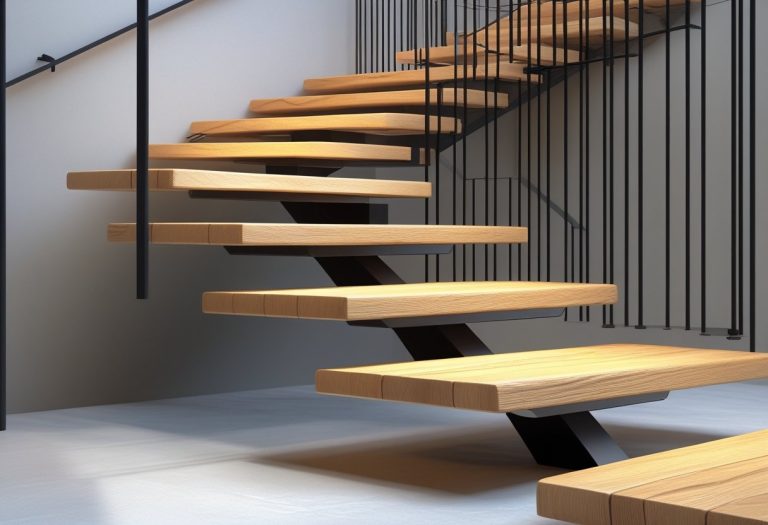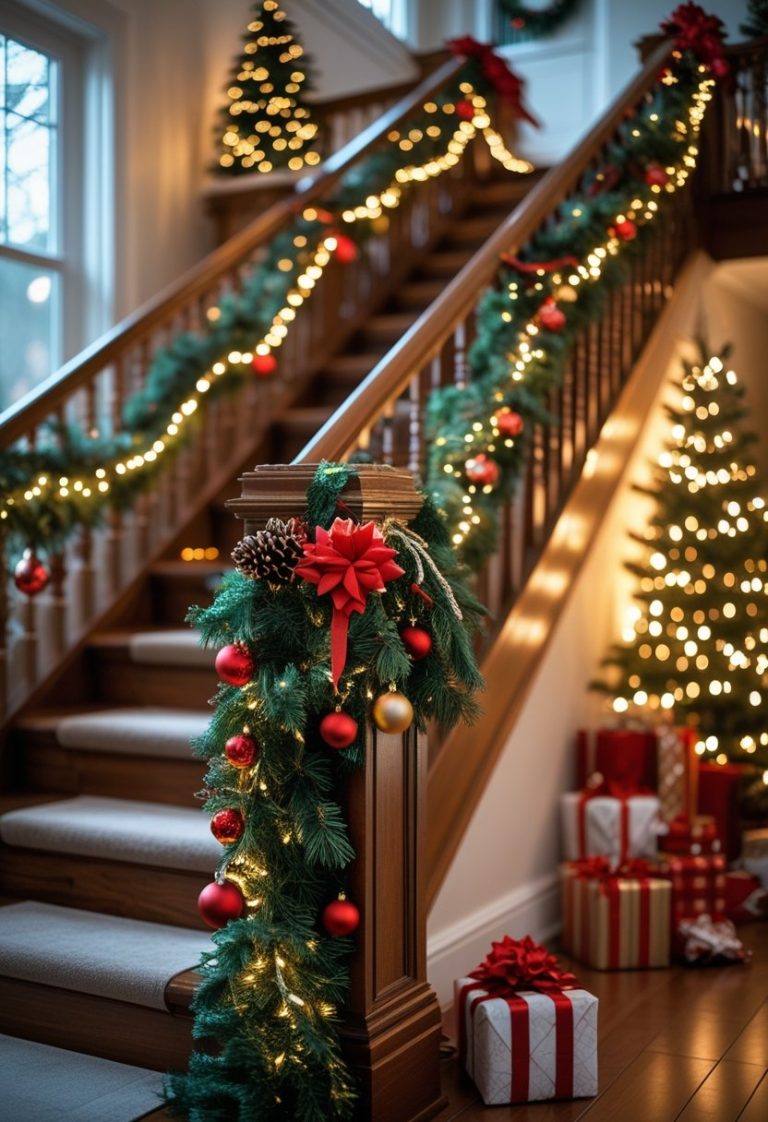Modern Staircase Design with Geometric Railing Style
Contemporary staircase design often balances the need for functionality with the desire for striking aesthetics. Geometric railings introduce clean lines and bold patterns that create visual interest while maintaining safety and structural integrity. Warm wooden accents soften these sharp designs, adding texture and a natural element that complements modern interiors.

A well-designed contemporary staircase merges sleek geometric details with inviting wood finishes to achieve both style and practicality in any home. This combination transforms staircases from simple connectors into key architectural features that enhance a room’s ambiance.
By focusing on material contrasts and thoughtful design, staircases incorporate space-saving solutions and elegant lighting, making them more than just a means of moving between floors—they become a defining element of the living space.
Core Elements of Contemporary Staircase Design
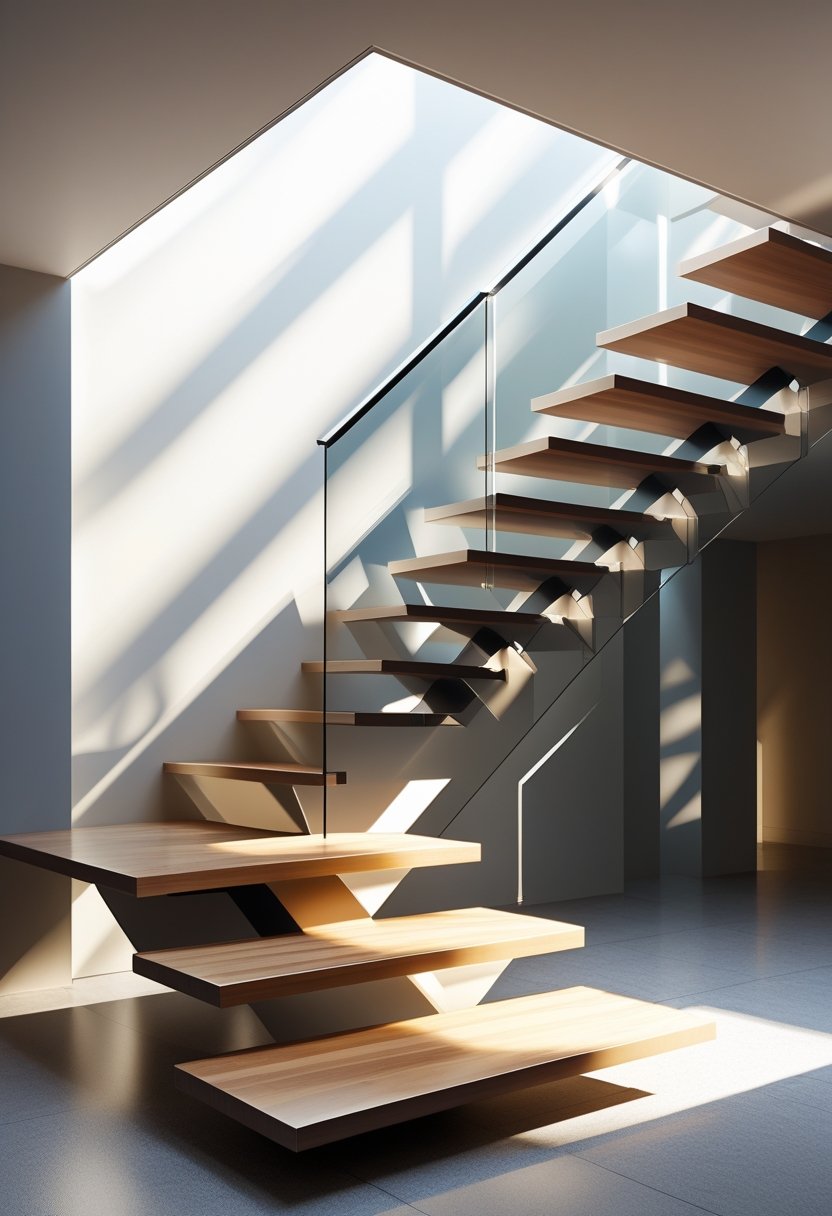
Contemporary staircases balance aesthetics with practical use, drawing attention through clean lines and thoughtful material choices. Key considerations include how the design maximizes space and light, while ensuring safety and ease of use in modern homes.
Balancing Style and Functionality
A contemporary staircase must deliver both visual appeal and secure, practical use. It often features geometric railings that act as artistic statements while providing sturdy support. The design includes precise proportions to ensure comfort in stepping, avoiding overly steep or shallow risers.
Integrated lighting, such as LED strips under steps, improves safety without disrupting the clean look. Functionality extends to storage options built beneath stairs, merging utility with style. Modern staircases emphasize durability and ease of maintenance, balancing sleek design with everyday use.
Emphasizing Open and Airy Concepts
Modern staircases often incorporate open risers or transparent materials like glass panels to create a sense of spaciousness. These choices allow natural light to flow through the structure, maintaining an open feel essential in contemporary interiors.
Avoiding bulky components keeps the staircase visually light. This approach fits well in smaller or multi-purpose areas by maximizing perceived space. Geometric railings, often made from metal or cable, add structure without closing off sightlines, enhancing the staircase’s sculptural quality.
Choosing the Right Materials
Material selection directly influences both style and longevity. Wood is popular for its warmth and natural texture, often paired with metal or glass to introduce modern contrasts. For railings, metals such as steel or aluminum provide strength and a sleek finish.
Glass panels increase transparency and modernity, while also offering safety without disrupting the design’s flow. The right combination—for example, warm wooden treads with geometric metal railings—creates balance. Materials are chosen not only for aesthetics but also for durability, ensuring the staircase suits the demands of daily use in modern homes.
The Impact of Geometric Railings
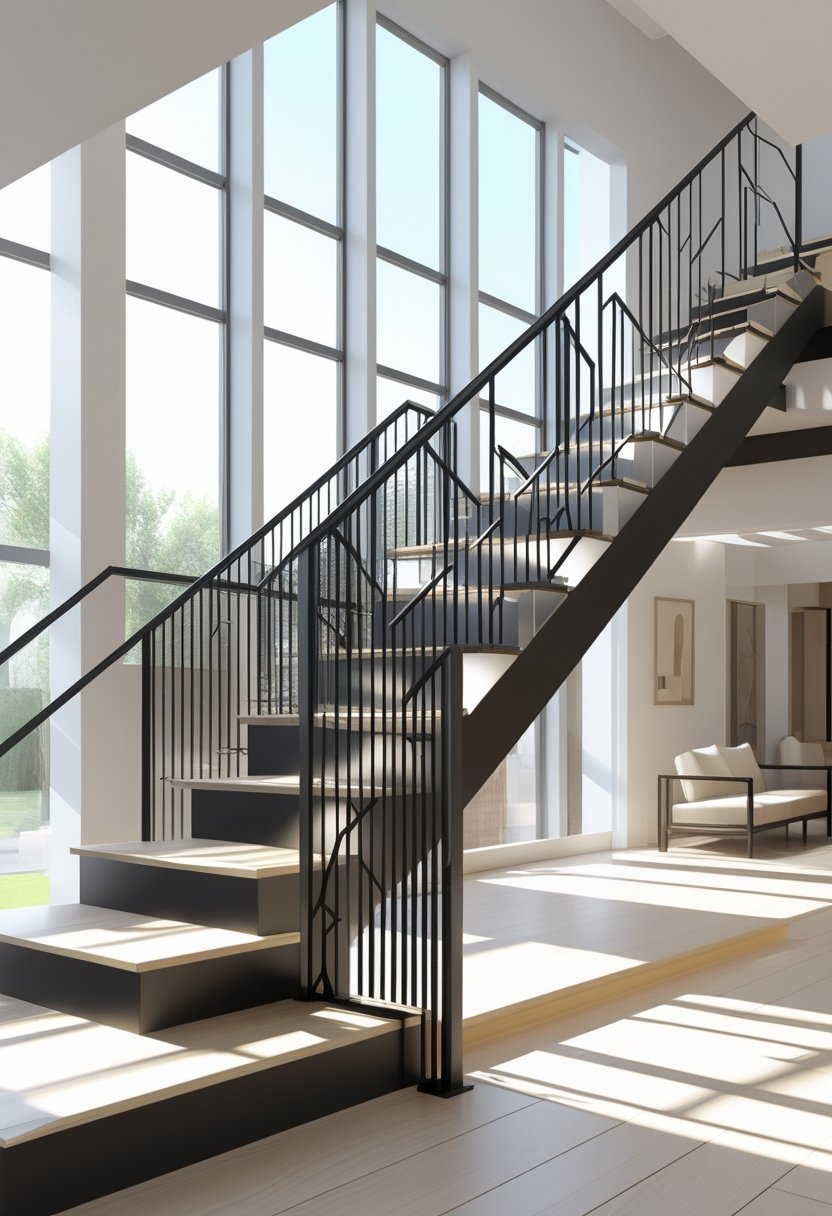
Geometric railings offer a precise balance of style and structural function, shaping the visual language of contemporary staircases. Their patterns define the space and influence lighting, texture, and the overall spatial experience. Focused choices in design and materials ensure that these railings become both an architectural anchor and a refined aesthetic statement.
Statement-Making Geometric Patterns
Geometric railing patterns use shapes like triangles, diamonds, and interlocking polygons to create visual interest. These often rely on repetition, symmetry, and angular lines to guide the eye.
Patterns such as diagonal bars or intersecting grids give staircases a bold and modern presence. When arranged thoughtfully, they can emphasize height and draw attention to a staircase’s form.
These designs also provide safety without creating visual bulk. The openness of geometric railings allows light to permeate the area, maintaining an airy feel.
Materials and Finishes for Railings
Metal railings are the most common choice for geometric designs due to their strength and flexibility. Steel and aluminum enable thin, clean lines that hold complex geometric shapes reliably.
Popular finishes include matte black, brushed nickel, and powder-coated colors that enhance durability while complementing various interiors. Metal’s reflective qualities can contrast or harmonize with warm wooden accents on stair treads or handrails.
Proper treatment prevents corrosion and maintains the railings’ sharp appearance over time. This combination of material and finish is crucial for balancing robustness with style.
Geometric Design Integration with Architecture
A geometric railing should align with the home’s architectural style for coherence. In modern or industrial spaces, metal railings with sharp, angular patterns complement minimalist or exposed materials like brick and concrete.
The integration with warm wooden accents softens the metal’s starkness, creating a blend of natural and engineered elements. This contrast highlights different textures and enriches the overall aesthetic.
When designed in harmony, the railing becomes part of a greater architectural narrative rather than a disconnected feature. This integration elevates both staircase function and design impact.
Warmth and Texture: Wooden Accents in Staircase Design
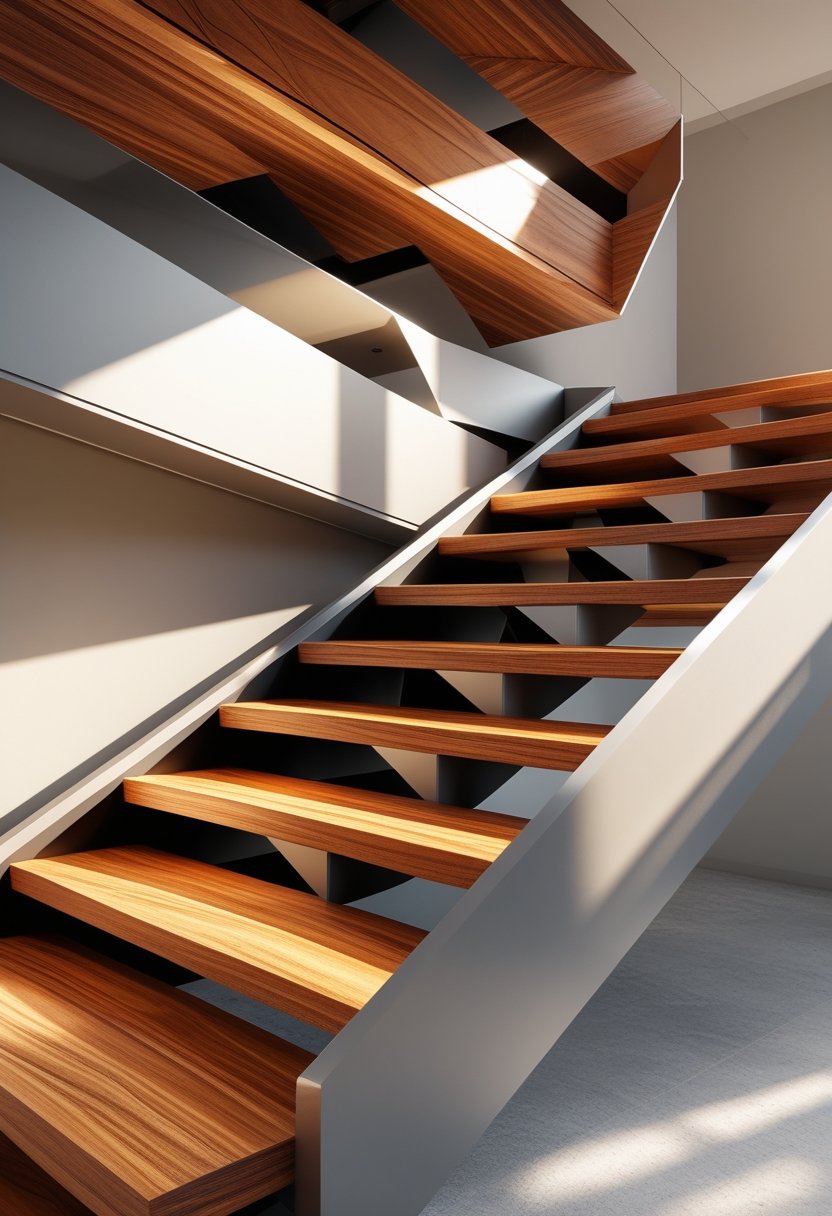
Wooden accents add depth and natural warmth to contemporary staircases, enhancing both aesthetics and comfort. Key factors include the type of wood used for treads, how wood pairs with other materials, and the finishing touches that define modern appeal.
Utilizing Wooden Treads for Visual Appeal
Wooden treads are a focal point in staircase design, offering tactile warmth and rich texture. They work well in various formats, such as floating staircases and wooden spiral staircases, where the wood’s grain can be fully showcased.
Choosing hardwoods like oak, walnut, or maple is common due to their durability and attractive finishes. Thickness and width also affect the look: wider treads create a solid, sturdy impression, while thinner profiles complement minimalist, floating designs. Additionally, contrasting wooden treads against metal or glass risers can create sharp visual interest without compromising warmth.
Mixing Wood with Modern Materials
Combining wood with sleek materials like glass, steel, or white-painted elements balances warmth with modernity. For example, wooden treads with glass railings maintain openness and lightness while preserving natural texture.
Metal supports paired with wooden steps emphasize geometry and structure, highlighting clean lines typical of contemporary design. Incorporating built-in storage beneath wooden staircases can also improve functionality without detracting from the wood’s tactile quality.
Floating wooden staircases exemplify this blend, where the absence of visible supports gives a minimalist feel, and the wood keeps it inviting rather than stark.
Finishes and Stain Selection for Contemporary Looks
Finish selection shapes the tone and durability of wooden staircase accents. Matte or satin finishes maintain a natural look without excessive shine, which fits contemporary styles better than glossy coatings.
Light stains reveal the wood’s natural color while brightening a space, especially in smaller stair wells or dark interiors. Dark stains, such as espresso or walnut, provide contrast when paired with white risers or metal railings, enhancing the staircase’s geometric designs.
Protective treatments like polyurethane increase resistance to wear without altering texture. Clear finishes that retain the wood’s natural grain emphasize authenticity and craftsmanship important in modern wooden staircase designs.
Popular Contemporary Staircase Styles
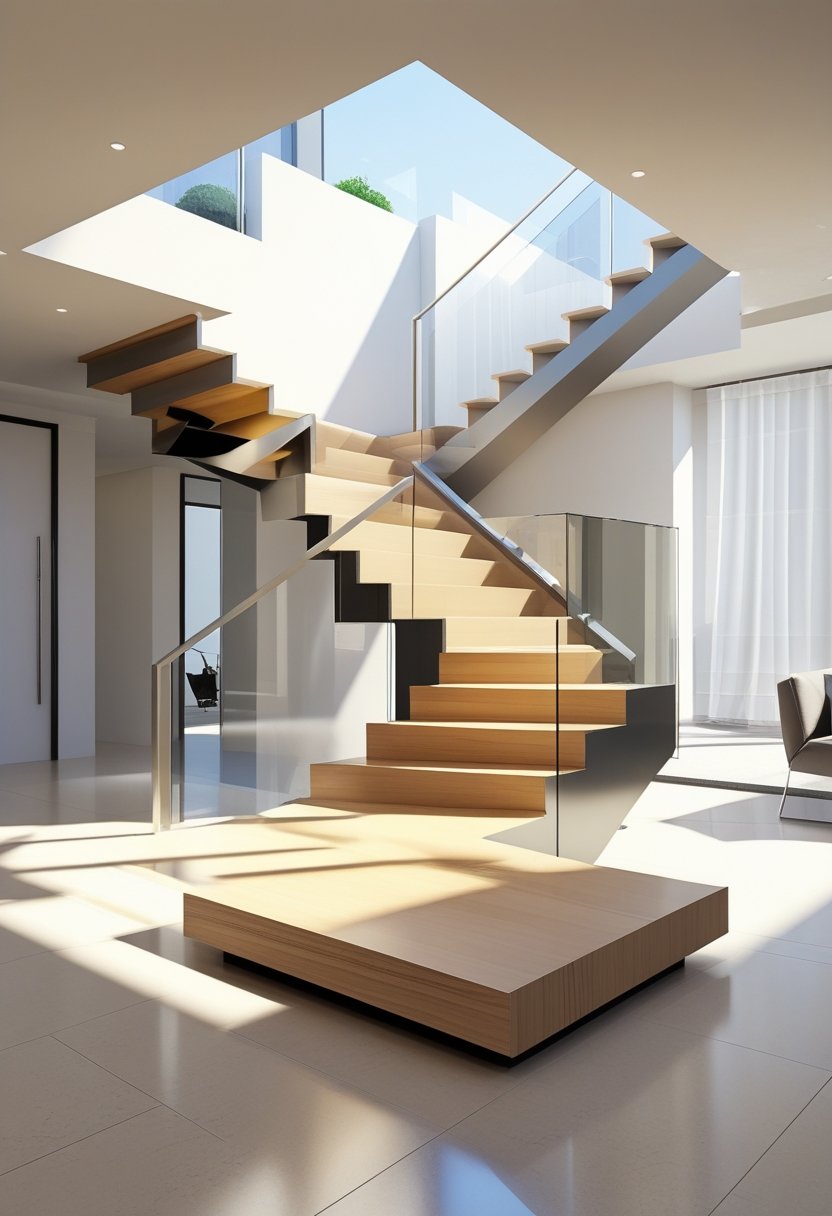
Contemporary staircases often combine clean lines, innovative shapes, and carefully chosen materials. Designers focus on maximizing space, light, and visual impact while maintaining practicality. The following styles highlight key trends and design choices in modern stair construction.
Floating and Cantilevered Staircases
Floating staircases create the illusion of steps suspended without support, offering a light and airy feel. Typically anchored on one side, cantilevered staircases extend steps directly from a wall, avoiding bulky stringers.
These styles often use warm wooden treads paired with glass or thin metal railings to balance softness with precision. This combination allows natural light to flow through while maintaining safety.
The minimalist look emphasizes open space beneath the stairs, making rooms appear larger. LED strip lighting is frequently installed under each tread to improve visibility and add subtle ambiance.
Spiral and Curved Staircases
Spiral staircases optimize vertical space, ideal for smaller areas. Their cylindrical shape fits compact footprints without sacrificing style.
Curved staircases provide smooth transitions between levels with graceful, flowing lines. They often serve as elegant focal points in open-plan homes.
Materials vary, but combining metal railings with wooden steps is common to introduce warmth and contrast. Both styles require careful engineering for safety and structural integrity due to their unique shapes.
Wide, Open, and Zigzag Staircases
Wide staircases offer a grand appearance while improving accessibility by providing ample step width. They work well in spacious interiors.
Open staircases lack risers between treads, contributing to a modern aesthetic and promoting light circulation. Zigzag staircases feature angular geometric shapes, often echoed in their railings.
These designs blend style and function by making movement visually interesting and comfortable. Wood accents alongside metal or glass elements help balance warmth and modernity.
Minimalist Metal Staircases
Minimalist metal staircases emphasize simplicity and durability. They frequently feature clean, straight lines with powder-coated steel or aluminum construction.
Railings are streamlined, focusing on geometric patterns such as squares, rectangles, or linear bars. These provide visual structure without overwhelming other design elements.
Metal staircases pair well with wooden treads or accents, softening industrial materials with natural textures. The emphasis is on functionality and an uncluttered appearance that complements contemporary interiors.
Maximizing Functionality in Modern Staircase Designs
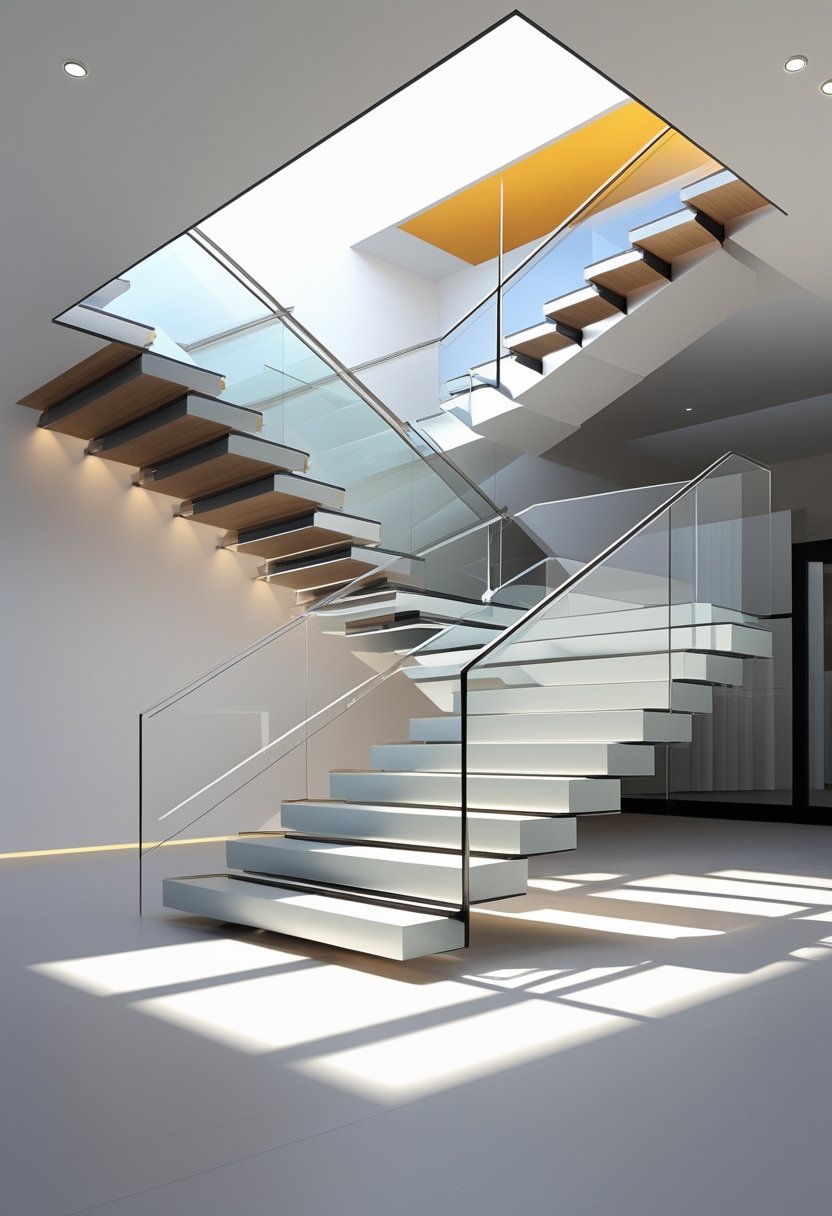
Effective staircase design balances space efficiency, safety, and user comfort without sacrificing aesthetic appeal. Achieving this involves clever integration of storage, thoughtful safety measures, and strategic lighting to enhance both usability and style.
Incorporating Storage and Multi-Use Features
Staircases with built-in storage optimize limited space while maintaining a clean look. Drawers or cabinets can be integrated beneath steps or within the staircase structure, offering concealed storage for shoes, books, or household items.
Multi-use features like seating nooks or display shelves along stair landings add practical functionality. Incorporating a stair runner can protect finishes and reduce noise, improving the stair’s usability while complementing wooden accents and geometric railings.
Safety Considerations Without Compromising Style
Safety elements are essential in modern staircases but need not disrupt design cohesion. Non-slip stair treads and well-fitted stair runners provide traction without detracting from clean lines or material choices.
Railings with striking geometric patterns can be engineered for strength and height compliance, ensuring protection without bulkiness. Clear glass panels or open risers maintain openness and visibility while meeting safety codes when combined with secure handrails.
Lighting Techniques for Practicality and Ambiance
Lighting enhances stair safety and defines ambiance through layered approaches. LED strip lights installed beneath each step illuminate the tread clearly, reducing trip hazards and adding subtle warmth to wooden surfaces.
Wall-mounted fixtures or recessed spotlights can highlight handrails and railings, emphasizing geometric designs. Combining functional lighting with softer accent lights creates a balanced environment that supports daily use and visual appeal.
Sustainable and Eco-Friendly Staircase Approaches
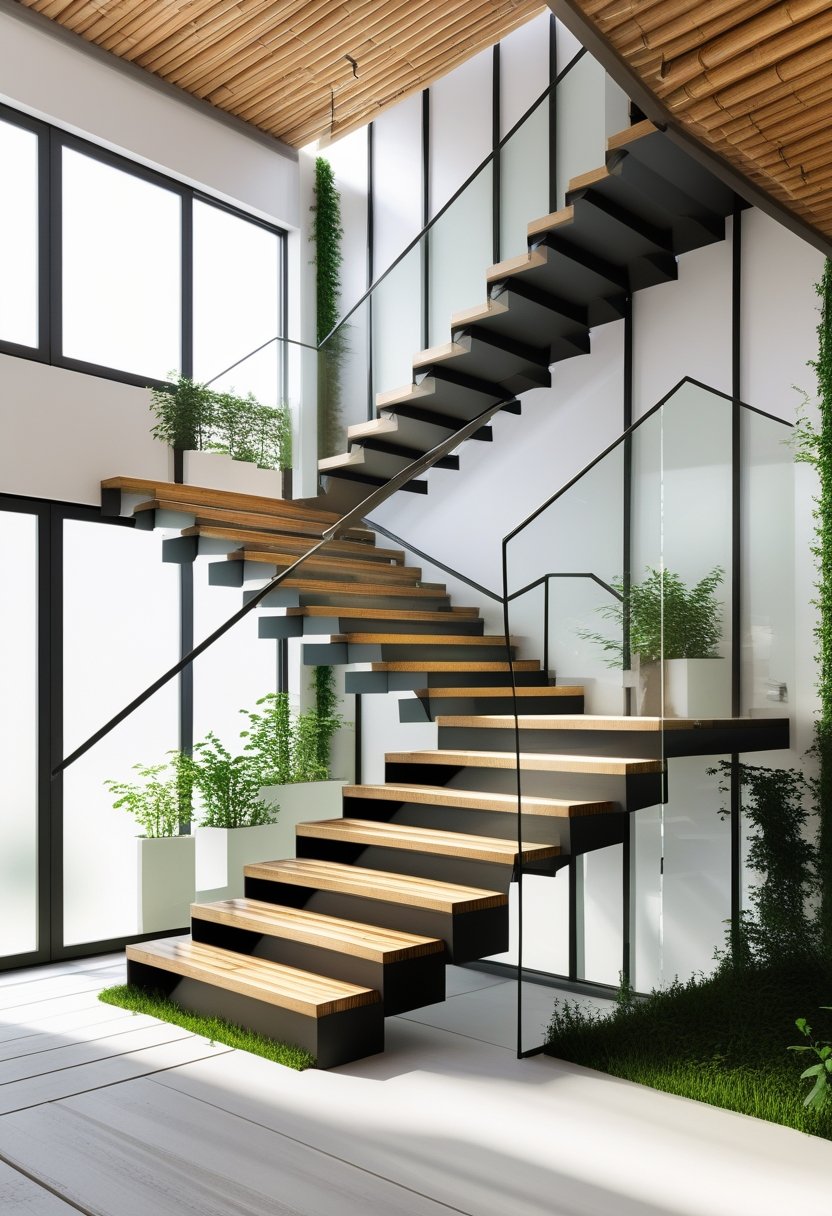
Staircase design today prioritizes materials and methods that reduce environmental impact without sacrificing durability or aesthetics. Wood, metal, and glass sourced responsibly can create structures that last and minimize waste. Efficiency in use of resources extends the lifespan and functionality of staircases.
Selecting Sustainable Materials
Using reclaimed wood for treads offers a low-impact alternative to newly harvested timber. This material retains warmth and natural beauty, enhancing geometric railing designs with organic texture. Bamboo is another option, known for rapid regrowth and strength, suitable for steps and accents.
Recycled metals provide structure while reducing the need for virgin resources. They support modern, industrial looks and pair well with wooden elements to balance warmth and sleekness.
Key considerations for selecting materials include:
- Source certification (FSC, SFI) for wood
- Durability to reduce replacement frequency
- Low-impact processing and transport
Attention to these factors helps ensure the staircase is both eco-friendly and visually striking.
Designing for Energy Efficiency and Longevity
Longevity in staircase design reduces waste and environmental toll. Using robust joinery methods and finishes enhances durability in daily use. Wood treatments that avoid toxic chemicals improve indoor air quality and maintain sustainable standards.
Energy efficiency can extend beyond the structure itself. Incorporating natural or LED lighting integrated into the design reduces energy consumption. Thoughtful placement of open risers or glass panels allows light flow, creating a brighter and more inviting space without extra power use.
Maintenance-friendly surfaces and modular elements streamline repairs and updates, encouraging longer use rather than full replacement.

Ana Luisa
Explore in-depth biographies, net worth insights, and exclusive updates on your favorite singers at Trionua.com. Discover the journeys, achievements, and latest news about music’s biggest stars.

